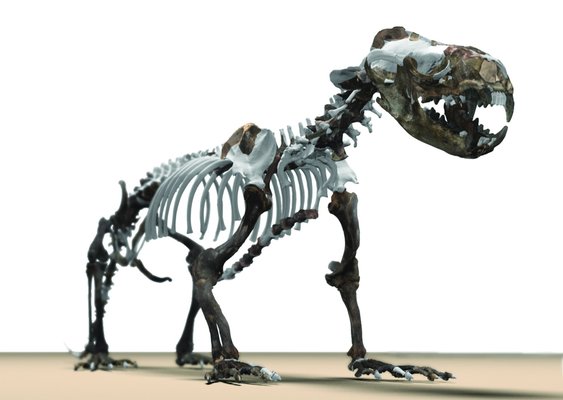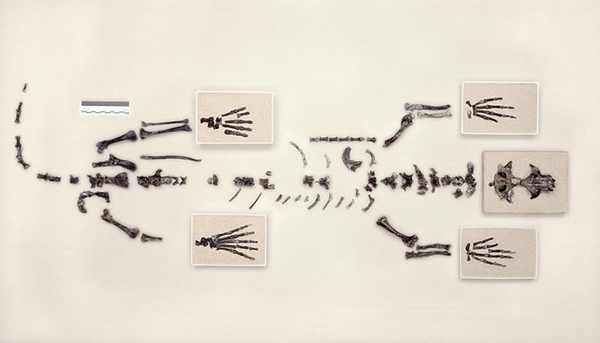
by Jennifer Singer Thursday, January 5, 2012

A reconstructed skeleton of _Puijila darwini_, a possible missing link between modern seals, walruses and sea lions and their terrestrial ancestors. Canadian Museum of Nature

Puijila darwini's skeleton. The fossil was discovered in Canada's High Arctic in 2007. Canadian Museum of Nature
A newly discovered web-footed mammal may be a “missing link” between land-based and marine pinnipeds, a group that includes seals, walruses and sea lions. The find, occurring on the 150th anniversary of Charles Darwin’s "On the Origin of Species," may shed new light on the land-to-sea animal evolutionary theory.
Until now, “the land-to-sea transition in pinnipeds has been difficult to study because the fossil evidence has been weak and contentious,” says vertebrate paleontologist Natalia Rybczynski of the Canadian Museum of Nature in Ottawa. Rybczynski discovered the fossil with vertebrate paleontologist Mary Dawson, curator emeritus of the Carnegie Museum of Natural History in Pittsburgh, Pa.
Puijila darwini, a carnivorous pinniped, is 20 million to 24 million years old and fills the morphological gap between terrestrial and marine pinniped ancestors. Rybczynski and Dawson discovered the fossil in 2007, in a meteorite impact crater on Devon Island in Canada’s High Arctic.
Scientists had fossil evidence for the pinnipeds’ “arctoid,” or bear-like, ancestors from the Oligocene (34 million to 23 million years ago), as well as for the semi-aquatic pinnipeds dating back to the beginning of the Miocene (23 million to 5.3 million years ago), Dawson says. “What we have found in Puijila is that missing link … that fills the morphological gap between what the ancestral form was like and the swimmers.”
Puijila’s skeleton was remarkably complete, Dawson says, and indicated that the organism had well-developed limbs and muscles as well as flattened phalanges, or toes. That suggests its feet were not flippered, like modern-day pinnipeds, but instead were webbed, the team reported this week in Nature.
These fossil remains suggest that the mammal was probably skilled at both swimming and walking on land, making it well-suited to its varied environment: In fact, the animal may have lived in the freshwater lake in which it was found, Dawson says. That, she adds, also lends support to the evolutionary theory that some organisms moved from land to freshwater and, eventually, to salt water environments.
“Normally we’re working from an impression in the ground or a handful of bones, so we were really lucky,” says scientific illustrator Mark Klingler of the Carnegie Museum, who did the illustrations for the study.
Puijila may also have a significant impact on theories about the origin of pinniped evolutionary development, Rybczynski says. Prior to this discovery, the earliest known pinnipeds already displayed full flipper development. Those pinnipeds had been found on the west coast of North America, which scientists thought was the focal point for pinniped evolutionary development. The Arctic’s extreme fluctuations in seasonal climate, however, might have helped shape the evolution of these animals, driving their evolution “into new trajectories,” she says.
Dawson agrees. “What we are postulating is that the origin of ancient sea lions took place in the Arctic, and these ancestral animals — which were still terrestrial — were able to move over land and able to finally populate the seas of coastal North America.”
“Like recent discoveries of an exceptional array of transitional whale fossils, this specimen helps fill in some of the stages of this important evolutionary sequence,” says paleontologist John Flynn of the American Museum of Natural History in New York City. The study has broader implications, as well, Flynn says: It can help scientists better understand how many other species of terrestrial animals may have adapted to marine environments.
“It becomes a study of evolutionary convergence,” Dawson says.
Puijila’s discovery is only the start of a long scientific journey, however. “The challenge of working in the Arctic means it’s really understudied,” Rybczynski says. She and her team plan to return to the site with the hope that, as further weathering occurs, more fossil evidence will be unveiled. “This is a starting point,” she says. “We’re only really beginning.”
© 2008-2021. All rights reserved. Any copying, redistribution or retransmission of any of the contents of this service without the expressed written permission of the American Geosciences Institute is expressly prohibited. Click here for all copyright requests.